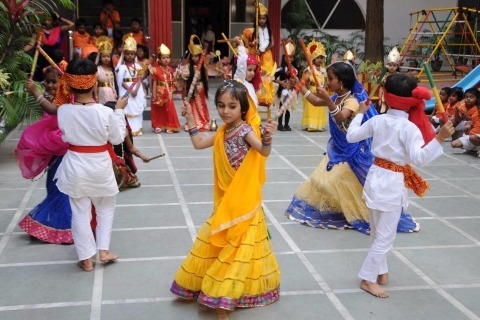
There’s more to Navaratri than just the Dandiya or Durga Puja! Pick up a fun idea from this list…
3 Oct 2016 | 4 min Read
Anshu Bhojnagarwala (firsttimemommy)
Author | 67 Articles
Do you know the festival of Navratri is celebrated in different ways across India? From North to South and East to West, Navratri celebration has a distinct flavour in every region. And, thus it makes it perfect for little kids to learn the cultural diversities and enjoy them.

Here are a few fun ways you can celebrate Navratri with your kids:
Playing dandiya: The bright lights, sound of dhols and fancy dandiya sticks…your kids will love it all! Dress up your kids in traditional finery; ghaghra choli for girls and kurta pyjama for boys and give them a pair of dandiya sticks. Though celebrated with much fanfare in Gujarat, there are many places in Mumbai (party plots, temples, residential complexes) that organize traditional garba and dandiya where you can take your kids. You might be able to find something near you as well.
Hopping Durga Puja pandals: Durga Puja is celebrated from the sixth day of Navratri, and you will find Puja pandals in every metro city today. The pandals are built on different themes and organize various cultural programmes through the day that are a delight to watch. These pandals are open for all, free of cost. Take your kids to see the huge Durga idols, taste authentic Bengali cuisine and watch traditional aarti and dance programmes of Bengal. Besides telling your child a bit about Goddess Durga herself.

Watching Ramleela: Your children might have read or heard many stories of God Rama. But, it will be a novel experience for them to watch Ramleela where over ten days, the entire story of Ramayana is enacted by men in costumes and makeup? And, on the tenth day, there is ‘Ravan Dahan’, where a huge effigy of the evil Ravana is burnt with fire crackers. And, don’t forget the fairs in the Ramleela maidans where your kids can enjoy candy floss, ferris wheels and balloons.

Playing with mud dolls Golu (Well, not actually playing!): In South India, mud doll festival Golu or Kolu or Bommai Kolu is widely celebrated. In this festival, especially Tamil families exhibit various dolls and figurines made of clay which are displayed on a makeshift staircase having odd numbered steps. Every home has a different collection of Golu dolls. These dolls usually depict a Mahabharata or Ramayana scene or 10 avtaars of Lord Vishnu, however, of late the themes are turning more modern. They are offered different prasadams for nine days. If you have friends who set up Golu, do not miss, it is a feast for the eyes! Your kids are sure to love them.

Praying on Ashtami: North Indians consider young (prepubescent) girls to be representations of the nine avataars of Maa Shakti. Hence, on Ashtami or Navami, they invite nine young girls from the neighbourhood, and honour them with halwa-puri, gifts, food, etc. It’s a beautiful experience where the men of the house wash the feet of young girls, apply vermillion on their forehead and then pray before them to their blessings, while the women of the house feed the girls with love and care. So, the next time, your Punjabi or Marwari neighbour requests you to send your daughter for Kanya pujan, do not hesitate, she will love the attention, and gifts (of course!).

Let your kids experience the beautiful festival of Navratri in these different ways and witness the rich cultural heritage of India.
Explore the entire collection of articles: Navratri
If you are reading this article on our website and have an Android phone, please download our APP here for a more personalised experience based on your lifestage.
A


Suggestions offered by doctors on BabyChakra are of advisory nature i.e., for educational and informational purposes only. Content posted on, created for, or compiled by BabyChakra is not intended or designed to replace your doctor's independent judgment about any symptom, condition, or the appropriateness or risks of a procedure or treatment for a given person.
